February 2023 / INVESTMENT INSIGHTS
For or Against? The Year in Shareholder Resolutions—2022
With environmental and social proposals in the spotlight, case-by-case insights were key to our decision-making.
EXECUTIVE SUMMARY
For the third year, we have published analysis of our voting results on shareholder resolutions of an environmental or social nature. After these resolutions earned unusually high support in 2021, we observed an increase in experimentation in 2022. We noted not only a large increase in the volume of proposals, an expansion of the types of topics brought to a vote, and growth in the population of proponents, but also an overall decrease in the quality of proposals.
Our approach to resolutions of this type continues to be examining them on a company‑by‑company basis as we decide how to vote. While trends in shareholder proposals change every year, our view is that accountability for environmental, social, and governance performance is best applied at the board level. We believe our 2022 voting record illustrates this principle clearly.
Within the context of growing demands on the private sector to align businesses in ways that also address significant societal challenges, shareholder resolutions have become a frequently used mechanism to foster dialogue between investors and corporate leaders. Our approach to such resolutions continues to be guided by careful attention to the end result within our well‑tested framework.
The Role of Proxy Voting in Stewardship
We see proxy voting as a crucial link in the chain of stewardship responsibilities that we execute on behalf of our clients. From our perspective, the vote represents both the privileges and the responsibilities that come with owning a company’s equity instruments. We vote our clients’ shares in a thoughtful, investment‑centered way, considering both high‑level principles of corporate governance and company‑specific circumstances. We take an inclusive approach to these decisions, with involvement from our environmental, social, and governance (ESG) specialists and the investment professionals who follow the companies closely. Our overarching objective is to cast votes in support of the path most likely to foster long‑term, sustainable economic performance for the company and its investors.
Our view is that the proxy vote is an asset belonging to the underlying clients of each T. Rowe Price Associates (TRPA) investment strategy. This means that our portfolio managers are ultimately responsible for making the voting decisions within the strategies they manage. To fulfill this responsibility, they receive recommendations and support from a range of internal and external resources, including:
- The T. Rowe Price Associates ESG Investment Committee
- Our global industry analysts
- Our specialists in corporate governance and responsible investment
- Insights generated from our proprietary Responsible Investing Indicator Model (RIIM)
- Our external proxy advisory firm, Institutional Shareholder Services (ISS)
Prudent Use of Our Influence
Our proxy voting program is one element of our overall relationship with corporate issuers. We use our voting power in a way that complements the other aspects of our relationship with these companies. For example, other contexts in which we might use our influence include:
- Regular, ongoing investment diligence
- Engagement with management on ESG issues
- Meetings with senior management, offering our candid feedback
- Meetings with members of the Board of Directors
- Decisions to increase or decrease the weight of an investment in a portfolio
- Decisions to initiate or eliminate an investment
- On occasion, issuing a public statement about a company—either to support the management team or to encourage it to change course in the long‑term best interests of the company.
The case study in Table 1 illustrates a typical climate-focused set of engagements.
Climate Risk Safeguarding Shareholder Resolutions (TRPA)
(Table 1)
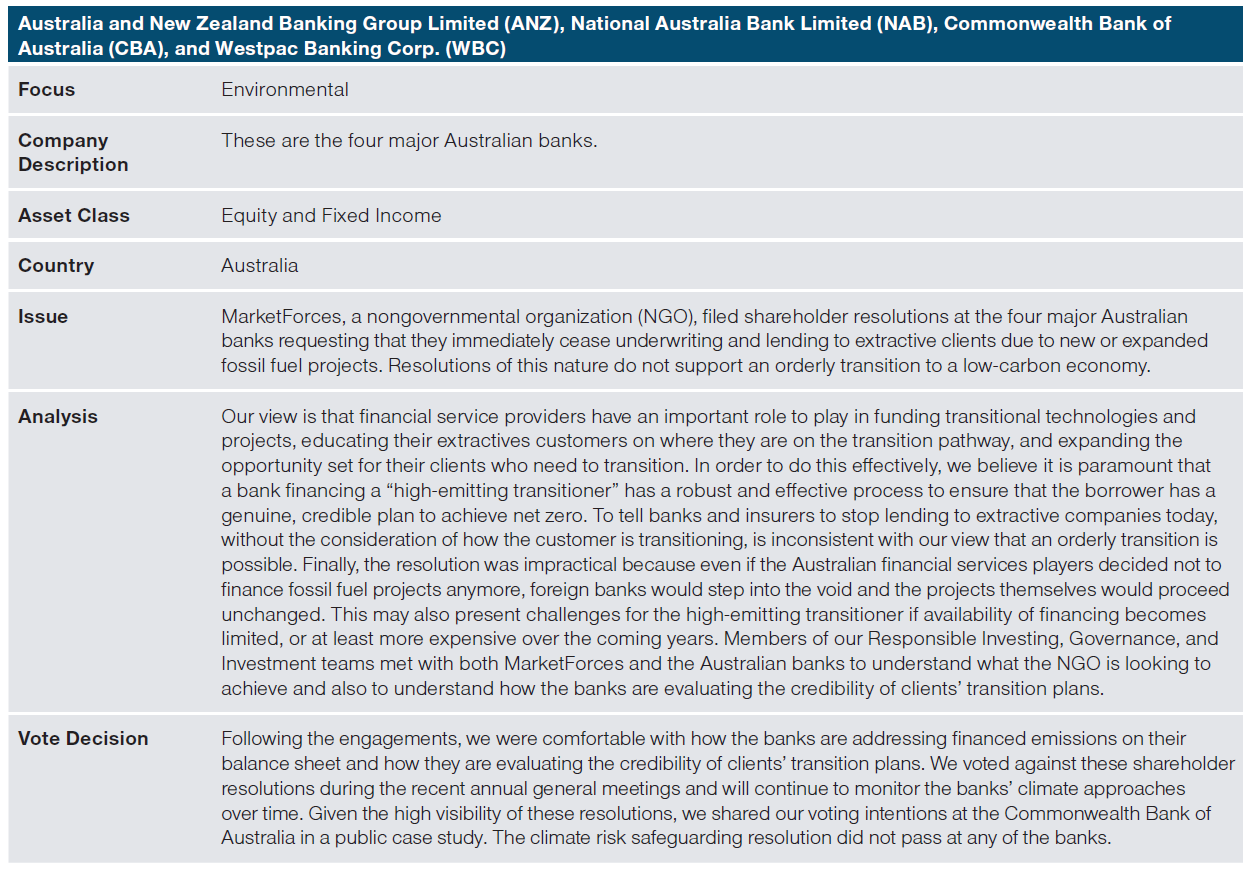
As of December 31, 2022.
Source: T. Rowe Price.
The specific securities identified and described are for informational purposes only and do not represent recommendations.
In an environment where large institutional shareholders are often rated by third parties according to how frequently they vote against Board recommendations, we wish to be clear—it is not our objective to use our vote to create conflict with the companies our clients are invested in. Instead, our objective is to use our influence, through the various avenues listed, to increase the probability that the company will outperform its peers, helping enable our clients to achieve their investment goals.
A proxy vote is an important shareholder right, but its power is limited to the one day per year when a company convenes its annual meeting. Influence—earned over time and applied thoughtfully—is a tool we use every day.
Varying Degrees of Regulation and Qualification
In some markets around the world, a company’s shareholders are afforded the right to present items to be voted upon at the annual general meeting. However, these shareholder proposals are subject to varying degrees of regulation and qualification. In some markets, sponsors are required to have large, long‑term holdings to be eligible to submit proposals, and as a result, shareholder resolutions are relatively infrequent and tend to be sponsored by institutional investors.
In other markets, particularly Japan, North America, and the Nordic region, filing requirements are minimal. As a result, it is common to see most resolutions in these regions submitted by individual investors and social advocacy organizations. In total, 70% of the resolutions that are the focus of this report were brought at U.S. companies.
Outside the U.S., another significant development is affecting voting patterns, particularly in the Europe, Middle East, and Africa (EMEA) region and Australia. In these markets, there is a growing embrace of voluntary, management‑sponsored climate resolutions, or so‑called say on climate votes. The purpose of these votes is for the company to present the details of its medium‑ and long‑term climate strategy and reporting to investors for their endorsement. In markets where the say on climate voting concept has not gained traction—notably Japan—the spotlight remains on a small number of high‑profile environmental resolutions brought by shareholders. In markets where the say on climate concept is more prevalent, we observe a more nuanced dynamic where the management‑supported resolution may compete with a proponent’s request for additional disclosure. In this reporting period, there were 45 say on climate votes across all TRPA global equity‑focused portfolios; we supported 97% of them.
Shareholder Resolutions Voted on in 2022
(Fig. 1) Digging deeper into E&S resolutions
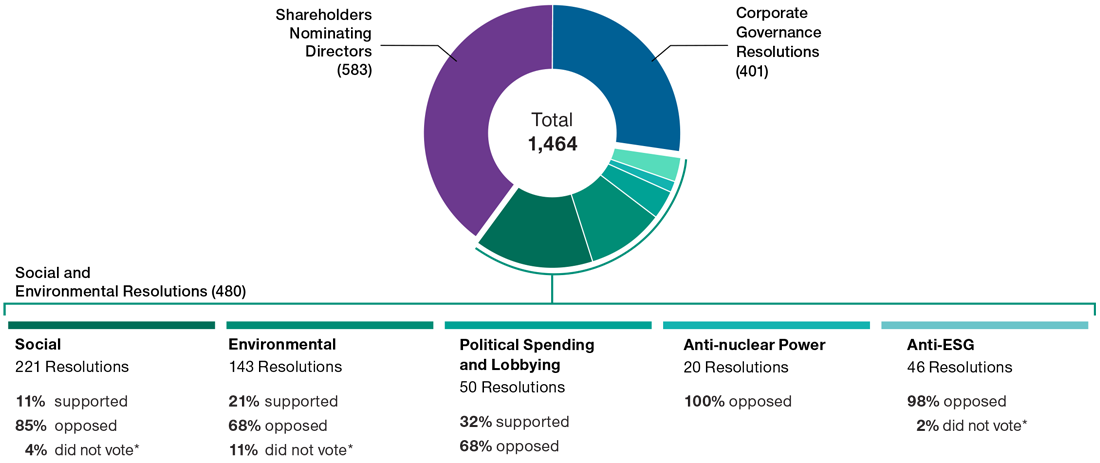
Chart shows the number of shareholder resolutions we voted on in 2022 by proposal topic. For “Social and Environmental Resolutions,” we classify the proposals into 5 distinct categories.
*There are two reasons we elect not to vote a certain resolution. The first is a technical requirement when voting in contested elections, where we vote on the proxy card of one side, but we enter “DO NOT VOTE” instructions on the other card. The second is due to share‑blocking, a requirement in certain markets that impose liquidity constraints in order to exercise voting rights. We generally do not vote in these markets.
As of December 31,2022.
Source: T. Rowe Price Associates.
In 2022, TRPA portfolio managers voted on 1,464 shareholder‑sponsored resolutions across all markets. Of those, 583 were situations where shareholders were nominating directors to a company’s Board or technical proposals related to such elections. Another 401 were resolutions asking companies to adopt a specific corporate governance practice. Here, we focus on the 480 remaining proposals that specifically addressed environmental and social (E&S) issues. We classify these proposals into five distinct categories, as illustrated in Figure 1.
Voting Framework: Principles‑Based or Case by Case?
When it comes to proxy voting issues, there is some debate as to the best approach: Is it best to look at each issue individually and consider the company’s circumstances or to apply a set of principles evenly across all companies? In our view, the answer is both.
There are many areas within proxy voting where a principles‑based approach can be implemented effectively. For example, our proxy voting guidelines are designed to promote an appropriate level of Board independence, robust shareholder rights, and strong link between executives’ compensation and company performance. However, there are other areas where a case‑by‑case approach is necessary in order to achieve full alignment between our guidelines and our voting outcomes. This is very much the case for shareholder resolutions.
The main reason why shareholder resolutions are hard to implement with a principles‑based voting approach is because they are more nuanced than other proxy voting categories. For example, we employ an objective set of indicators to determine a director’s independence. It is a straightforward decision to vote against existing directors and suggest that the company replaces them with independent Board members. In the case of many shareholder proposals, the message to the company is not only that it needs to make a change, but also to employ a prescriptive method to do so. We often find ourselves agreeing with a proponent that a company’s E&S disclosure is inadequate. However, we do not always agree with the prescriptive remedy.
The activities of the anti-ESG movement in the U.S. added complexity to our decision‑making framework in 2022. While we have built multiple avenues to seek feedback from our global clients, many of who place a high priority on ESG integration or impact investing, we are aware that we have just as many clients who express no views on such matters. Some even hold negative views about the potential effects an ESG orientation may have on their investment outcomes or regional economies. A top priority for 2023 will be to engage proactively with a wider set of client populations and other stakeholders to ensure we are receiving a balanced picture of our clients’ priorities and perspectives with regard to the prioritization of ESG.
Dramatic Shifts in the Proxy Voting Landscape
A notable development in proxy voting for 2022 was the increase in the number of shareholder‑sponsored resolutions. Last year in this report we examined the 323 environmental and social resolutions voted across T. Rowe Price portfolios. This year that figure increased by 49% to the 480 proposals we examine in this report. There are multiple reasons for this increase. We have observed a general increase globally in investor engagement on environmental and social concerns, and some of that increased focus results in resolutions submitted for a vote. The other primary reason was a decision by the U.S. Securities & Exchange Commission (SEC) to adapt its interpretation of what types of resolutions were eligible to be added to a company’s proxy. The SEC allowed more proposals across a wider range of environmental and social topics to move forward. Our observation is that the increase in the volume of proposals resulted in a decrease in their overall quality. We observed more inaccuracies in proposals this year, more poorly targeted resolutions, and more proposals addressing non‑core issues. In fact, the category with the largest increase in volume was anti‑ESG resolutions, which request that companies unwind their investments in environmental and social improvements. Last year, TRPA voted only nine of these resolutions; this year it was 46.
In addition, we observed a marked increase in the level of prescriptive requests. Proponents have moved swiftly from disclosure‑based requests (seeking additional reporting on ESG matters) to action‑based requests (seeking specific commitments, capital investments, or structural changes from the targeted companies). At the same time, proponents exhibited a lower propensity to negotiate settlements with issuers before taking a proposal to a vote.
These dramatic shifts in the landscape reinforced our commitment to a company‑by‑company approach to voting on these proposals. It is more important than ever to understand the company’s overall circumstances, disclosure levels, performance, and material ESG risks before determining votes on these proposals.
Understanding Our Voting Rationale
We classify E&S resolutions into five distinct categories
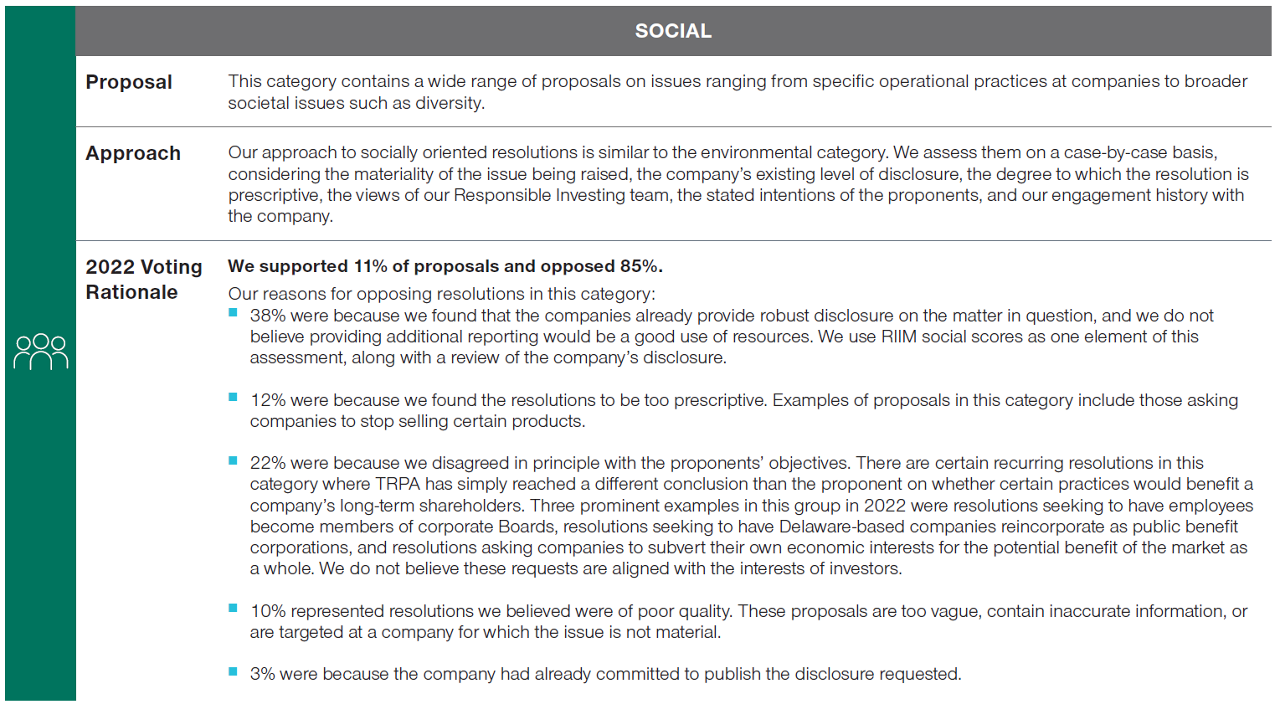
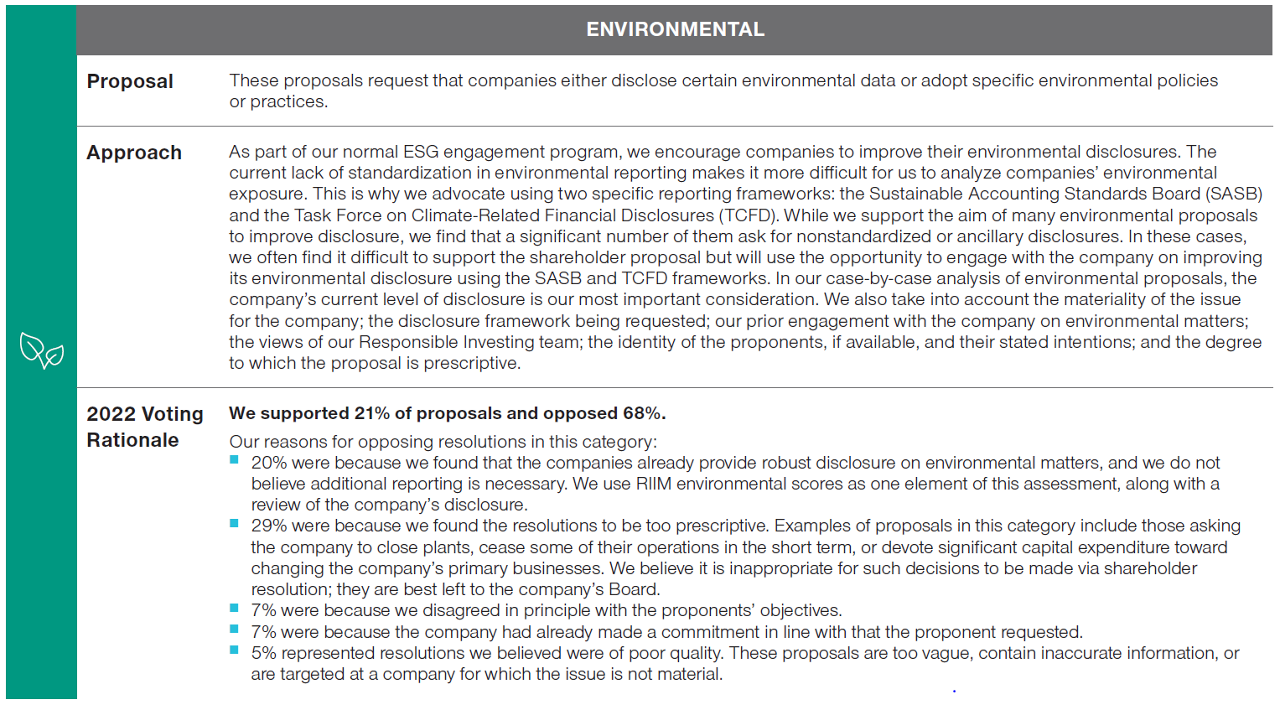
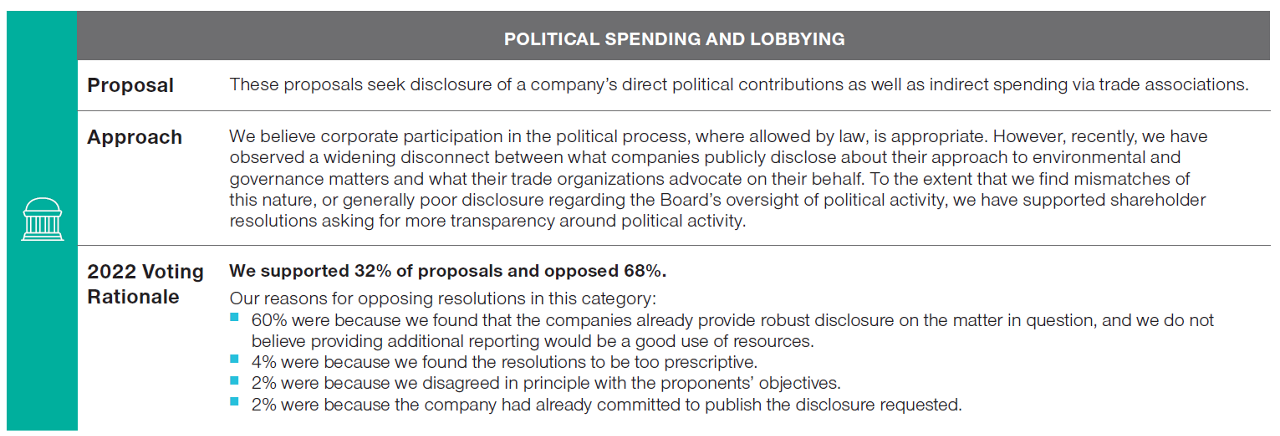


The Policy Formation Process at TRPA
Our approach to voting on E&S shareholder resolutions is one small part of our overall responsibilities related to proxy voting. This approach continuously evolves along with the overall corporate backdrop. It is informed by changes in regulation, improvements in corporate disclosure, campaigns by stakeholders, company‑specific events, and our investment professionals’ views on these matters. The TRPA ESG Investment Committee is made up of experienced investment professionals, including analysts and portfolio managers from our Equity, Fixed Income, and Multi‑Asset Divisions as well as Investment Division leadership. In addition, the membership includes cross‑functional expertise from internal legal counsel, business unit management, and investment operations. The committee is cochaired by our head of Corporate Governance and our director of Research for Responsible Investing. The committee’s first meeting of each year is to review proxy voting activity from the year before, to reassess the suitability of our voting guidelines, and to consider adding to or amending the guidelines.
Multiple Avenues of Accountability for ESG Performance
It is important to note that shareholder resolutions are not the only way that our views on environmental and social factors are expressed in the TRPA proxy voting program. For almost every company around the world, directors are reappointed as part of the regular business of the shareholder meeting. Before we vote to reelect them, we assess these directors’ performance across multiple dimensions, including environmental and social.
In 2022 we adapted the TRPA voting guidelines in three ways that led to an increase in our level of opposition of directors due to ESG concerns. These policies were:
- Climate Transparency Gap: For companies deemed to be in high‑emitting industries, we generally oppose board members if the companies fail to disclose sufficient greenhouse gas emissions data to enable investors to assess risk.
- Board Diversity: We apply a minimum standard for boards’ gender diversity in every market globally, with higher standards applied in regions where there is governing regulation or a market standard.
- Shareholder Rights: We generally oppose board members at seasoned U.S. companies that continue to elect directors in staggered, three‑year terms, as these structures reduce boards’ accountability to investors.
In 2022, the outcome of these three policy adaptations was that TRPA opposed more than 1,000 additional directors when compared with our previous policy.
Voting Decision Elements
The following table details the specific considerations that we take into account when assessing E&S resolution.


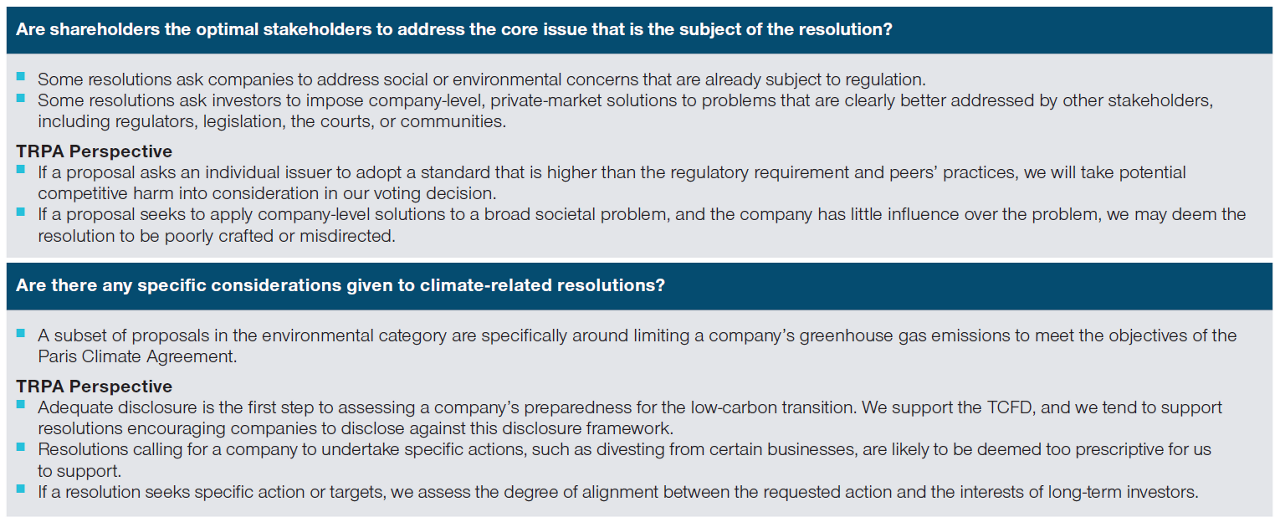
The tools we use to reassess the suitability of our voting guidelines each year include (a) a review of the previous year’s voting patterns, including an analysis of the cases where we decided to override our policies, and (b) an analysis of up‑and‑coming ESG issues, informed by our internal research and data from a variety of external sources, such as our proxy advisory service, our trade associations, and proponents of shareholder resolutions. The robust discussions held each year by this committee ensure that the TRPA Proxy Voting Guidelines remain fit for purpose, incorporating changes in the global ESG landscape as they happen.
Oversight of Proxy Voting and ESG at TRPA
Proxy voting is an investment function within T. Rowe Price. This is part of our service offering as investment advisers, and it is subject to the Boards of Directors oversight of the various T. Rowe Price investment advisers. The T. Rowe Price advisers have fiduciary responsibilities. It is the duty of the advisers to vote shares in portfolio companies solely in the interests of their clients, taking into account factors relevant to a long‑term investor.
The ESG Investment Committee reports annually to all the funds’ (U.S. mutual funds, SICAVs, trusts, and OEICs) Boards of Directors. We provide a detailed overview of year‑over‑year changes in voting patterns, amendments to the voting guidelines, and a discussion of the management of potential conflicts of interest. We also provide a detailed analysis of our votes on E&S matters.
In addition to the funds’ Boards, which exercise direct oversight over the T. Rowe Price advisers, T. Rowe Price Group, Inc. (Group), is a publicly traded corporation with a separate Board of Directors. The Group Board also has an interest in ESG matters in that it oversees the corporation’s ESG strategy, environmental footprint, human capital management, risk management, and other related functions.
The ESG capability of the T. Rowe Price advisers is a strategic issue of interest to the Group Board. For this reason, our firm’s senior ESG leaders provide annual updates to the Group Board. These presentations focus on our firm’s investment in our ESG capabilities: technology resources, talent, tools, training, and products managed under ESG frameworks. Our proxy voting activity is generally not part of the discussion because oversight for such investment activities is the responsibility of the funds’ Boards.
Review of Alignment Between Corporate and Investment Perspectives on Climate Risk
In response to a request by the T. Rowe Price Group, Inc., Board of Directors, in 2022 we updated our previous comparison of the firm’s corporate‑level policies, views, and statements on climate change against the proxy voting activities of the firm’s investment advisers.
More detailed information on this review, including methodology and findings, is provided as an appendix to this document (Appendix: Climate Risk Alignment Review).
Conclusion
T. Rowe Price’s investment advisers have dedicated significant resources toward building ESG expertise and insight. Consistent with our strategic investing approach, voting decisions on these matters are made using case‑by‑case analysis, taking into account the company’s particular ESG risks, opportunities, and disclosure.
Our overall framework for integrating ESG factors into the TRPA investment process—which includes proxy voting—is research centered. Its purpose is to produce investment insights for our internal teams of analysts and portfolio managers. As a global asset manager serving as a fiduciary for clients with different perspectives, beliefs, time horizons, and investment goals, it is not our objective to build our investment strategies around a specific set of values. Instead, our objective is to apply different lenses (environmental, social, ethical, and governance) to deepen our understanding of the investments held in our clients’ portfolios.
The quality, intent, and utility of shareholder resolutions on ESG matters are highly variable at this time. Some well‑targeted resolutions are helpful in persuading companies to strengthen their management of certain risks, leading to improved outcomes for investors. Other resolutions are not helpful—we would even call them harmful—if the objectives of the proponent do not align with economically oriented, long‑term investors. This is why we believe that the most responsible approach to voting such resolutions is to apply the thoughtful, investment‑focused framework we have discussed in this report.
Appendix: Climate Risk Alignment Review
In response to a request by the T. Rowe Price Group, Inc., Board of Directors, in 2021 we conducted an initial analysis comparing the firm’s corporate‑level policies, views, and statements on climate change against the proxy voting activities of the firm’s investment advisers. In 2022 we refreshed the analysis. For purposes of this report, we refer to “corporate” activities as those pertaining to T. Rowe Price Group, Inc., as overseen by its Board of Directors. We refer to “investment” activities as those pertaining to the various T. Rowe Price investment advisers established to advise and manage assets on behalf of our advisory clients—including all of our U.S. mutual fund and other commingled fund shareholders—and other investment advisory clients. Collectively, these companies are known as the Price Advisers, and they are overseen by and accountable to separate Boards of Directors.
We note that T. Rowe Price Group, Inc., and its Board of Directors are not responsible for overseeing the proxy voting activities of the investment subsidiaries of the company. Such activities are conducted at the direction of, and overseen by, the Price Advisers. The shareholders and stakeholders of these two entities are distinct, and they may have different interests. Nevertheless, we elected to take this opportunity to evaluate the question of whether incongruities exist between the investment advisers’ proxy voting record and the policies of T. Rowe Price Group, Inc.
To conduct this analysis, we compared climate‑related statements from the following documents:

*T. Rowe Price Investment Management, Inc. (TRPIM) makes independent proxy voting decisions, as described in their proxy voting guidelines, from T. Rowe Price Associates, Inc. (TRPA) and its investment advisory affiliates.
Step 1: High‑Level Perspective
Documents from both entities address climate change directly. Our corporate disclosures state “T. Rowe Price’s leadership is aware of the risks and opportunities climate change poses to its business.” They add: “As investors, we have always believed long‑term thinking and sustainability go hand in hand.” Similarly, the Price Advisers’ disclosures state: “How our investments are positioned to navigate climate change is a key concern for our analysts and portfolio managers. We believe it is part of our fiduciary duty to understand how our investee companies are assessing their exposure to climate change and are building environmental sustainability into their long‑term strategic planning.”
For both entities, climate change features as a prominent topic in our ESG‑related disclosures.
Step 2: Disclosure
Documents from both entities mention disclosure of greenhouse gas emissions and plans to reduce them as key early steps that corporations can take to allow investors to begin to assess and mitigate risks around climate change. Both entities specifically highlight the Task Force on Climate‑Related Financial Disclosures (TCFD) as their preferred framework for approaching such disclosure. They also both mention the Sustainability Accounting Standards Board (SASB) as their preferred disclosure framework for sustainability issues more generally.
On the corporate side, T. Rowe Price Group, Inc., is a public supporter of the TCFD framework and incorporated recommendations from the TCFD into its 2021 Sustainability Report. Among the data disclosed is a breakdown of the corporation’s total greenhouse gas emissions.
On the Price Advisers side, the TRPA Proxy Voting Guidelines specifically mention the funds’ tendency to support shareholder resolutions seeking TCFD reporting. Also, the ESG Annual Report and other documents mention that our engagement efforts with portfolio companies often center on advocacy for better environmental disclosure, including recommending adoption of the TCFD framework.
Both entities espouse the value of using common frameworks for environmental reporting, specifically TCFD and SASB.
Step 3: Proxy Voting
Consistent with its duties to vote shares in portfolio companies solely in the best interests of our clients, the Price Advisers have established an ESG Investment Committee for each of its separate advisers, which serve an independent function to oversee the voting process and to establish and maintain custom voting guidelines. The guidelines mention climate change as a voting issue in several places. However, there is no specific guideline set out for any shareholder resolutions of an E&S nature. This is due to the Price Advisers’ belief, as fundamentally oriented investors, that these issues must be viewed through a company‑specific lens.
Our perspective is that issuers have very different exposure to climate‑related risks, depending on their geographic locations, their business models, regulation, leadership, and the long‑term nature of the energy transition. Issuers also provide very different levels of disclosure on these issues, ranging from full TCFD‑aligned reporting provided by certain larger companies in more climate‑sensitive industries to smaller companies that have not even started to measure their emissions yet. Therefore, the Price Advisers’ voting guidelines lay out an approach to analyze such proposals on a case‑by‑case basis.
A review of the documents on the corporate side confirms that there are no disclosures that mention proxy voting specifically. This is appropriate, considering that the corporate entity and its Board of Directors are not responsible for voting or overseeing the proxy voting activity of the Price Advisers.
Summary of Findings
After reviewing the documents listed, we conclude the following:
- that both entities’ general, high‑level perspectives on the investment risks associated with climate change are aligned,
- that both entities’ strong support for the TCFD and SASB reporting frameworks is further evidence of alignment, and
- that there is no misalignment between the two entities’ disclosures on proxy voting.
Furthermore, we conclude the Price Advisers’ proxy voting records for 2020, 2021, and 2022 were consistent with their Proxy Voting Guidelines and strongly demonstrate a case‑by‑case analysis of each climate‑oriented proposal voted by Price Advisers’ portfolios.
T. Rowe Price understands and embraces our various stakeholders’ interests in climate change as an important investment consideration. This applies to stakeholders of the corporation, such as T. Rowe Price Group, Inc., shareholders; our communities; and our associates. It also applies to stakeholders of the Price Advisers, such as our investment clients.
We are committed to providing consistent reporting and candid assessments of our activities on both the corporate and investing sides of our business. This is the third year we have published this For or Against report providing detailed reporting around the Price Advisers’ proxy voting on E&S resolutions. We will continue to publish this analysis annually in addition to our detailed, company‑level vote disclosures, which are reported twice a year.

IMPORTANT INFORMATION
This material is being furnished for general informational and/or marketing purposes only. The material does not constitute or undertake to give advice of any nature, including fiduciary investment advice, nor is it intended to serve as the primary basis for an investment decision. Prospective investors are recommended to seek independent legal, financial and tax advice before making any investment decision. T. Rowe Price group of companies including T. Rowe Price Associates, Inc. and/or its affiliates receive revenue from T. Rowe Price investment products and services. Past performance is not a reliable indicator of future performance. The value of an investment and any income from it can go down as well as up. Investors may get back less than the amount invested.
The material does not constitute a distribution, an offer, an invitation, a personal or general recommendation or solicitation to sell or buy any securities in any jurisdiction or to conduct any particular investment activity. The material has not been reviewed by any regulatory authority in any jurisdiction.
Information and opinions presented have been obtained or derived from sources believed to be reliable and current; however, we cannot guarantee the sources’ accuracy or completeness. There is no guarantee that any forecasts made will come to pass. The views contained herein are as of the date written and are subject to change without notice; these views may differ from those of other T. Rowe Price group companies and/or associates. Under no circumstances should the material, in whole or in part, be copied or redistributed without consent from T. Rowe Price.
The material is not intended for use by persons in jurisdictions which prohibit or restrict the distribution of the material and in certain countries the material is provided upon specific request. It is not intended for distribution to retail investors in any jurisdiction.


